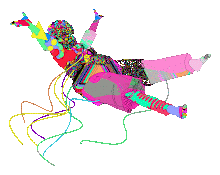Tonight after dark celebrate Astronomy Day by seeing how good your eyes are at telling colors of stars. Look in the west and find the crescent moon.
The first reddish object to the lower right of the moon is the planet Mars. A little further out from Mars towards the horizon is the star Pollux in the constellation Gemini. The moon and Mars however are in the constellation Cancer. The moon is great to look at in this phase with binoculars or telescopes because it has a lot of cool shadows cast by the mountains. You can also see other cool little craters.
In parts of Africa, Europe and Asia, the moon and Mars will appear so close together as seen from Earth that the moon will pass in front of Mars. This is called occultation of Mars by the moon. Some of the mountains and other features were first mapped during an occultation. In 2001, while astronomers were observing a lunar occultation, a meteor struck the moon. For those that are in the viewing area of the occultation find out more here.
In February 2009, you will be able to see two NASA probes crash into Earth’s moon. You will need a telescope to see this, but as the date approaches there will be lots of astronomy clubs/observatories having viewing parties.
If you have those binoculars still handy, you may be noticing a fuzzy patch near the moon. This is the open cluster known as The Beehive. An open cluster is a group of stars that form out of the same stellar cloud. Directly below the moon is a bluish white star that may be catching your eye as well. This is Procyon in the constellation Canis Minor.
photo credit: Doug Zubenel




Sem comentários:
Enviar um comentário